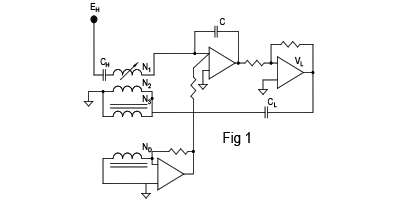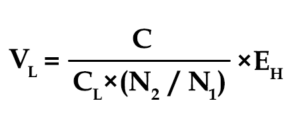
The model 2500A, 2501A, 2502A and 2503A complete the low-voltage arm of a high-voltage capacitive divider. Based on the compensated-current-comparator it provides ultra-precise ratio division of high AC voltages down to measurable levels. The output of the divider can be read by an AC/DC transfer device for precision measurements of the input voltage or by a precision power analyzer such as the MI model 2020A for direct measurements of transformer or reactor losses under control of the IEEE-488 interface.
Model 2500A: The input current to the model 2500A is supplied by applying a high-voltage to a low-loss high-voltage capacitor (100 pF for 120 kV, 50 pF for 240 kV) on its input. Several gain stages of 1, 2, 5, 10, 20, 50 and 100 are built in to allow flexibility for various input voltages. On gain 1 the full-scale input is 120 kV while gain 100 offers a full-scale input of 1,200 Volts. The full-scale output is 120 Volts for 120 kV in with 10 % overrange.
To apply 240 kV to the same divider a 50 pF standard capacitor is used on the input. On gain 1 the full-scale input is 240 kV while gain 100 offers a full-scale input of 2400 Volts. The full-scale output is 120 Volts for 240 kV in with 10 % overrange.
Model 2501A: The model 2501A will accept inputs up to 2400 Vac using a 1000 pF standard capacitor on its input. On gain 1 the full-scale input is 2400 V while gain 100 offers a full-scale input of 120 Volts. The full-scale output for each range is 120 Volts.
Model 2502A: The model 2502A will accept inputs up to 480 kV when a 100 pF standard capacitor is used and 960 kV when a 50 pF standard capacitor is used on the input. Several gain stages of 1, 2, 5, 10, 20, 50 and 100 are built in to allow flexibility for various input voltages. On gain 1 the full-scale input is 480 kV while gain 100 offers a full-scale input of 4,800 Volts. The full-scale output is 120 Volts for all ranges. For an input capacitor of 50 pF, the full-scale input is 960 kV. On gain 1 the full-scale input is 960 kV while gain 100 offers a full-scale input of 9.6 kV.
Model 2503A: The model 2503A will accept inputs up to 300 kV when a 50 pF standard capacitor is used and 150 kV when a 100 pF standard capacitor is used on the input. Several gain stages of 1, 2, 5, 10, 20, 50 and 100 are built in to allow flexibility for various input voltages. On gain 1 the full-scale input is 360 kV while gain 100 offers a full-scale input of 3.0 kV with 10 % overrange. For an input capacitor of 100 pF, the full-scale input is 150 kV. On gain 1 the full-scale input is 150 kV while gain 100 offers a full-scale input of 1.5 kV. The full-scale output is 100 Volts for all ranges.
A 1,000 pF low-loss stand capacitor is supplied with each unit as the reference capacitor. An optional high-voltage capacitor ranging from 1,000 pF, 2 kV to 800 kV can be ordered to be used on the input of the divider.
Operating Principle: A simplified schematic of the current comparator based voltage divider is shown in Figure 1. The current in the low-loss high-voltage capacitor (CH) is compared, using the current comparator, with the current obtained by applying the output voltage VL to a stable low-loss standard capacitor (CL).

Due to the magnitude and phase errors of EL, the current comparator will not be in ampere-turn balance. The difference current derived from the output of the detection winding ND is added through the feedback circuit to the current in the solid dielectric capacitor Cf resulting in a highly accurate and self-balancing voltage at VL. Thus the feedback circuit is used to provide an ampere-turn balance in the current comparator to correct the magnitude and phase errors of the output voltage VL.
The output voltage VL of the current comparator based divider is given by:

From the above equation, the capacitance ratio of CH and CL and the current comparator-winding ratio determine the divider output. Several gain stages are provided to ensure that the output voltage is always operated at near or full-scale. To change the gain on the high-voltage divider, a decrease in the current-comparator-winding ratio (N2/N1) is required to maintain an ampere-turn balance. Relays, which are used to change the electronic gain and winding ratio are driven simultaneously to keep the winding ratio times the gain constant. The gain of the divider is set, as 1, 2, 5, 10, 20, 50, 100 where 1 corresponds to a voltage at VH of 100 kV, 200 kV on the 2500A, 480 kV or 960 kV on the 2502A and 300 kV or 150 kV on the 2503A. Gain 100 would represent an input voltage at VH of 1 kV, 2 kV, 5 kV and 10 kV respectively. The uncertainty of the high-voltage divider is equal to the uncertainty associated with the two-stage current transformer and the uncertainty of CH and CL. On the 2503A, Gain 100 would represent an input voltage at VH of 3 kV and 1.5 kV.
Low Loss Capacitor and Feedback Capacitor
For the divider to have a zero temperature coefficient and loss-less high-voltage capacitor CH the stability and accuracy of the divider are determined by the stability and accuracy of the divider are determined by the stability and accuracy of the low-loss standard capacitor and the gain of the feedback circuit. Capacitor CL is a 1,000 pF low-loss standard capacitor with dissipation and magnitude errors and a temperature coefficient of a few ppm. The capacitance values of CL and Cf have been chosen to provide a nominal output voltage of 100 Volts for all units.
Current Comparator
The current comparator used in the high-voltage divider is a two-stage-compensated current comparator. The ratio turns consists of N1, which is variable, and N2 equal turns. The compensation winding N3 is connected in parallel with N2, which has the same number of turns to reduce its leakage impedance. The detection winding ND is connected to a current-to-voltage converter to obtain a voltage proportional to, and in phase with, the unbalanced ampere-turns in the current comparator.
Feedback Circuit
The gain of the feedback circuit, approximately 100, is sufficient for the feedback circuit to correct for the dissipation factor and capacitance variation of the solid dielectric feedback capacitor (Cf). The feedback circuit is set to 100 %.
All models are front panel and IEEE-488 controllable. The two LCDs monitor the internal test voltages and output of the divider. The divider is housed in a rack-mounted enclosure and is fully protected against transients. All connections are made to the rear of the instrument.
Loop Gain Check
The high-voltage divider has two conditions that it can be operated in, Open-Loop and Closed-Loop. To verify the loop gain and that the current comparator feedback is functioning properly an error can be introduced using the Gain Trim potentiometer. The Gain Trim potentiometer along with a Null Indicator is located on the front panel of the divider. In an open-loop condition, the gain trim potentiometer can be adjusted to minimize the error as indicated on the null indicator. For example, a 500 ppm error introduced in the Open-Loop Mode should be reduced to 5 ppm when the loop is closed. In operation, the divider is always operated in a closed-loop.
Applications
1. Reactor Loss Measurement Systems
2. Transformer Loss Measurement Systems
3. AC High-Voltage Measurement Systems
4. Power Calibration Systems
2500A
| Input Capacitor 100 pF | Input Voltage: 120, 60, 24, 12, 6, 2.4, 1.2 kV |
| Output Voltage: 120 Volts | |
| Input Capacitor 50 pF | Input Voltage: 240, 120, 48, 24, 12, 4.8, 2.4 kV |
| Output Voltage: 120 Volts |
2501A
| Input Capacitor 1000 pF | Input Voltage: 2400, 1200, 600, 480, 360, 240, 120 V |
| Output Voltage: 120 Volts |
2502A
| Input Capacitor 50 pF | Input Voltage: 480,240, 96, 48, 19.2, 9.6, 4.8 kV |
| Output Voltage: 120 Volts | |
| Input Capacitor 50 pF | Input Voltage: 960, 480, 192, 96, 38.4, 19.2, 9.6 kV |
| Output Voltage: 120 Volts |
2503A
| Input Capacitor 50 pF | Input Voltage: 300, 150, 60, 30, 15, 6, 3 kV |
| Output Voltage: 100 Volts |
General
| Maximum Primary Output Voltage | 120 Vac RMS with 10 % overrange |
| Division Ratio Uncertainty | Magnitude < 20 ppm Quadrature < 20 ppm |
| Frequency Range of Measured Values | 40 Hz to 400 Hz |
| Gain Selection | 7 Gain Setting of 1, 2, 5, 10, 20, 50, 100 |
| Warm-Up Time | < 5 Minutes to Full Rated Accuracy |
| Operating Environment | 10 to 34 °C, 10 to 18 % RH |
| Warranty | 1 Year Parts & Labour |